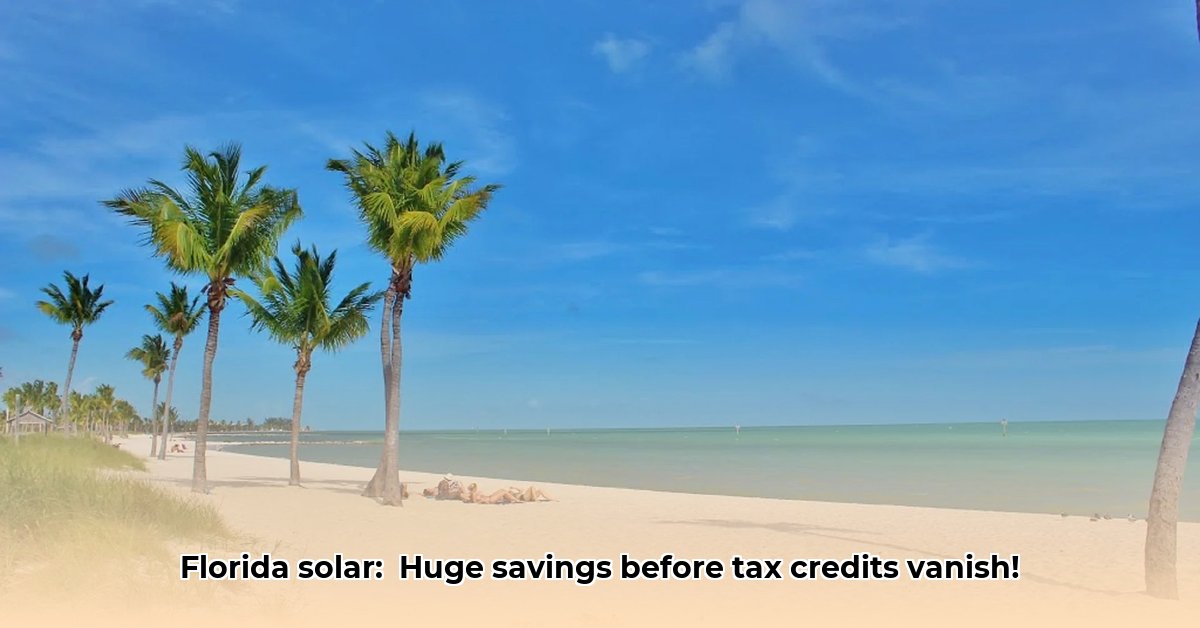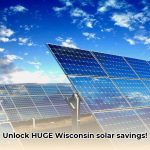Considering solar energy in Florida in 2025? This guide equips you with the vital information to make informed decisions, covering costs, incentives, installer selection, and long-term maintenance. Discover how to maximize savings and contribute to a greener future before critical tax credits expire.
Understanding Florida Solar Energy Costs
Considering powering your Florida home with solar energy to lower your utility bills? With federal tax incentives expiring soon, now is the time to examine costs, explore incentives, and select a reliable installer.
Decoding Solar Costs in the Sunshine State
How much will solar panels actually cost in Florida? Factors like system size and installation influence the upfront investment. The final price depends on many variables. Let’s examine the main cost drivers:
- System Size: A larger system providing more energy costs more. A typical Florida home might need a system around 7.2 kilowatts (kW), but your specific needs will determine the size and cost.
- Panel Type: Monocrystalline panels are more efficient but pricier than polycrystalline panels.
- Installation Costs: Installation isn’t a one-size-fits-all expense. The cost varies based on location, roof complexity, and the installer’s expertise and overhead.
- Inverter Type: String inverters are generally less expensive than microinverters but may not optimize energy production for each panel.
- Permits and Inspections: These fees are set by your local government, so check your county’s requirements upfront. Costs can add up.
You might need roof repairs before installation. If your roof is old or damaged, these unexpected costs can impact your total project expense. Get a roof inspection as part of your solar assessment.
Many homeowners want battery storage, which adds another layer to the costs. A battery system ensures power during outages, offering peace of mind and energy independence.
Here’s a general cost range, but remember these are estimates, and your actual costs may differ:
| Component | Typical Cost Range (USD) | Things to Consider |
|---|---|---|
| System Size (kW) | $10,000 – $40,000+ | Depends entirely on your energy usage. Get a professional assessment to determine what you need. |
| Panel Type | Varies | Monocrystalline panels offer higher efficiency but come at a premium cost compared to polycrystalline options. |
| Installation | $5,000 – $15,000+ | Installer experience, roof complexity, and location all play a role. |
| Inverter Type | Varies | String inverters are cheaper, while microinverters optimize each panel’s performance. |
| Permits & Inspections | $500 – $2,000 | Contact your local authorities to get exact pricing for your area. |
| Potential Roof Work | $0 – $10,000+ | A pre-installation roof inspection is a wise investment. |
| Battery Storage | $5,000 – $20,000+ | While optional, batteries provide backup power. |
Sweetening the Deal: Incentives and Financing Options
What financial incentives are available to make solar more attainable in Florida? How can homeowners take advantage of them before they expire? The big one is the federal Investment Tax Credit (ITC), currently offering a 30% tax credit. This applies to the total cost of your solar system, including equipment and installation. This credit is scheduled to decrease in future years, acting now makes financial sense.
Florida itself often offers additional incentives, such as sales tax exemptions or property tax abatements. The availability of these incentives varies by location and can change, so it is important to check with your local government for the most up-to-date information. You can usually find details on your county’s official website.
Beyond tax breaks, various financing options exist to help manage the upfront costs. You can likely secure a loan with manageable monthly payments or explore a Power Purchase Agreement (PPA), where a third party owns the system and you buy the electricity it produces. Each option has advantages and disadvantages, so carefully compare your choices. Consulting a financial advisor specialized in renewable energy financing is highly recommended. Solar leases are another option, similar to PPAs, but involve leasing the solar panels from a third party.
Choosing the Right Installer: A Crucial Step
Selecting a reliable solar installer is critical for a smooth and successful installation. Don’t rush this decision! Here are some key steps:
- Check licenses and insurance: Ensure your installer is properly licensed and insured in Florida to protect yourself. Don’t hesitate to ask for proof of these credentials.
- Read online reviews: See what past customers have to say about their experiences with different installers. Check reputable sites like the Better Business Bureau and EnergySage.
- Get at least three quotes: This allows for robust comparison shopping, ensuring you get a competitive price. Be sure the quotes detail the equipment being used, warranty terms, and estimated energy production.
- Ask detailed questions: Inquire about warranties, equipment specifications, and the overall installation process. Don’t hesitate to ask for clarifications if you are uncertain about anything. Ask about the installer’s experience with similar homes in your area.
- Get everything in writing: Thoroughly review the contract before signing to ensure you fully understand the terms and conditions. Pay close attention to clauses related to payment schedules, cancellation policies, and dispute resolution.
Thorough research is your best friend when dealing with solar installers.
Navigating Potential Risks: A Realistic Look
Like any significant investment, solar energy comes with potential risks:
| Risk Factor | Likelihood | Potential Impact | Mitigation Strategies |
|---|---|---|---|
| Panel Degradation | Medium | Reduced energy output over time | Choose high-quality panels with strong warranties. Regular cleaning also helps. |
| Hurricane Damage | Medium to High (depending on location) | Significant damage and repair costs | Invest in hurricane-resistant mounting systems, which are crucial in Florida’s climate. Ensure your system is installed according to local building codes. |
| Federal ITC Expiration | High | Loss of significant financial incentive | Act before the end of 2025 to take advantage of the current high credit. |
| Price Volatility | Medium | Unexpected cost increases | Secure a fixed-price contract with your installer to lock in current prices. |
| Insurance Issues | Low to Medium | Higher insurance premiums or claims issues | Discuss your solar system with your insurance provider. |
| Net Metering Changes | Low | Reduced Savings | Stay informed about potential changes to net metering policies in your area. |
Your Solar Journey: A Step-by-Step Guide
Here’s a roadmap to guide you through the process:
Step 1: Assess Your Energy Needs: Analyze your household electricity consumption to determine the appropriate system size. Your utility bill will provide valuable data here. Online solar calculators can provide an initial estimate.
Step 2: Gather Multiple Quotes: Contact at least three different licensed and insured solar installers for detailed proposals. Compare their pricing, equipment offerings, warranties, and proposed timelines. Ask each installer about their experience with net metering in your area.
Step 3: Explore Incentives and Financing: Investigate federal, state, and local incentives to maximize your savings. Determine the best financing option (loan, PPA, or cash purchase) based on your budget and financial goals.
Step 4: Select Your Installer and System: Choose the installer that best meets your needs and provides a comprehensive solution. Sign a detailed contract outlining all aspects of the project.
Step 5: Schedule and Oversee Installation: Coordinate the installation with your selected installer, ensuring they adhere to building codes and safety protocols. Monitor the installation progress.
Step 6: Post-Installation Monitoring: Track your system’s energy production and compare it to your electricity bills to gauge your savings. Many systems offer online monitoring tools. Regularly clean your panels to maintain optimal performance.
Going solar in Florida offers substantial long-term benefits – financial savings, environmental responsibility, and energy independence. But remember: careful planning and due diligence are key. Don’t wait; the incentives won’t last forever!
Maximizing Florida Solar Tax Credits Before the 2025 Deadline
With Florida’s solar tax credits set to expire soon, how can homeowners take advantage of these savings? Let’s explore the steps necessary to seize these incentives.
Understanding Your Solar Investment
Before you jump in, it’s crucial to understand the costs involved. Think of it like buying a car – there’s more than just the sticker price. Your total solar cost includes:
- System Size & Type: The size of your system depends on your energy needs. Larger systems cost more but produce more electricity. Different panel types also impact pricing and efficiency.
- Installation: Labor costs vary by installer and system complexity. Get multiple quotes!
- Permits & Inspections: These aren’t free. Budget accordingly, and contact your local permitting office for accurate estimates.
- Financing: Loans,
- Hydro Extrusions USA Leads North American Aluminum Profile Solutions - December 28, 2025
- Hydro North America Leads Aluminum Extrusion Solutions Across Diverse Industries - December 27, 2025
- Hydro Extrusion North America Provides Custom Solutions Across Diverse - December 26, 2025
















